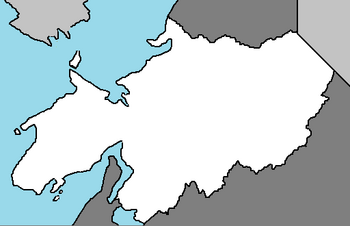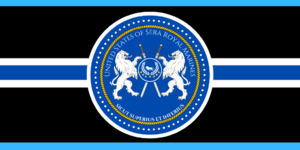Unified Sera
The United States of Sera Syra'yte doh Pro'ven Uso | |
|---|---|
|
Flag | |
| Motto: Not For Self, But Country | |
| Anthem: I Vow to Thee, My Country[1] | |
 Present Day map of Unified Sera | |
 A map showing the 23 individual states that make up the federation including the territory of Xanthus. | |
| Capital | Kito'Bahari |
| Largest city | Ayotola |
| Official languages | Seran, Latin, Kiswahili, English |
| Demonym(s) | Seran |
| Government | Federal Constitutional Monarchy |
• Monarch | Skolas Keegar Tu'Aruc ya Koga |
| Akan Khalfani ya Mbaku | |
• Speaker of the Senate | Gabadeli Uyise ya Koga |
• Secretary of State | Julius Clamentius ya Latinius |
• Secretary of Defense | Jabari Mansa ya Mbaku |
• Secretary of the Treasury | Djene Laku ya Sakhile |
• Chief of Staff | Mufari Sifa ya Koga |
| Senate | |
| Chamber of Representatives | |
| Establishment | |
• Seran Tribes settle a small portion of the Seran coast | circa 1200 B.C. |
• The Quadrumvirate comes into power | circa 1400 A.D. |
• Unification Day | June 7, 1741 |
| Population | |
• 2020 estimate | 50,000,000 |
• Density | 122.3/sq mi (47.2/km2) |
| GDP (nominal) | 2020 estimate |
• Total | 530.56 billion |
• Per capita | 11,600 |
| HDI (2019) | 0.89 very high |
| Currency | Unity |
| Date format | mm-dd-yyyy |
Unified Sera, officially known as the The United States of Sera (Syra'yte doh Pro'ven Uso) is a federal constitutional monarchy located on the Adula continent in the Coalition of Crown Albatross. It shares land borders with Peoratia and Buckingla, and it also shares maritime borders with Austrolis and Timeria along the southwestern arm of the Albarine Sea and the Sea of Austrolis. Geographically, Unified Sera has a sizeable coastline in the Sea of Austrolis with several beaches, dockyards, and shipping ports that extend Seran commerce into the greater world.
The capital of Kito’Bahari (‘’the Ocean’s Jewel’’) is located in the Seran state of Kado near the northwestern portion of the country. The capital is home to the Palace of Kings; the official residence and seat of power of the monarch which lies within the ancient homeland of the Koga tribespeople. The other branches of government are split between the ancestral homelands of the other tribes with the legislative branch located in the Latinius home of Aeminium, the judicial in the Mbaku homeland of Anansi, and the executive in the Sakhile’s origin Shaka. The separation of the 4 parts of Sera’s government was an integral part to Sera’s founding. The Quadrumvirate desired a unified country where they would all be equals and therefore placed each branch of government in the four tribes that made up what would become Sera.
The majority of Unified Sera’s GDP comes from the manufacturing, arms manufacturing, agriculture, and technology industries.
Etymology
History
Pre-Discovery (10,000 B.C.E.-1700 A.D.)
Human development and migration
Early civilizations
18th-19th Centuries
Early Expansion
Early 20th Century
Geography and Climate
Cities
|
Largest Census Metropolitan areas in Unified Sera by population | |||||
| No. | CMA City |
Population | |||
| 1 | Ayotola | 9,543,000 | |||
| 2 | Kito'Bahari | 7,326,000 | |||
| 3 | Sankore | 5,786,000 | |||
| 4 | Armansi | 3,523,000 | |||
| 5 | New Providence | 3,289,000 | |||
| 6 | Invicta | 3,181,000 | |||
| 7 | Jengo | 2,967,000 | |||
| 8 | Mombasa | 2,823,000 | |||
| 9 | Djenne | 2,423,000 | |||
| 10 | Novarii | 2,393,000 | |||
| 11 | Axsum | 2,133,000 | |||
| 12 | Carthage | 1,912,000 | |||
Education
Ethnicity
Family Structure
Language
Religion
Predominant faiths
Cults
Government
Eligibility for Political Office
Monarch
Military
United States of Sera Army
The United States of Sera Army, also called the Unified Sera Army, US Army, and Seran Army is a branch of the Seran military beneath the High Command of the Armed Forces. The US Army was officially established on June 7th, 1736 by the Quadrumvirate in the present day capital of Kito'Bahari in response to growing external threats to the Union of Seran Tribes. Before the establishment of a national army, each state in the Seran Union provided their own troops and commanders for national defense. These commanders were prone to disagreements with each other, while soldiers from different tribes would routinely fight amongst themselves due to cultural differences. The Quadrumvirate sought to nullify the worst offenders by removing them from their position and sending them to prison to avoid possible coups against the Quadrumvirate. Soon thereafter, new commanders were appointed from within the tribes to take their place with a particular focus on unification and standardization over individualization and cultural differences.
Originally, the US Army handled both peacekeeping tasks domestically within the first tribal states while also juggling the demands of protecting the borders around the fledgling country from the neighboring violent tribes of ancient Adula. The Quadrumvirate, fearing nepotism, instituted a system amongst Sera's warriors that rewarded soldiers with prestige, wealth, and position for accomplishing certain tasks. These tasks included bringing the heads of enemy war-leaders, scalps, securing weaponry, repelling attacks, and spear-heading successful raids against enemy territories. Due to the ferocity at which Seran warriors pursued enemy heads and scalps, a reputation began to grow amongst their neighbors surrounding Seran brutality in war.
This reputation continued to grow as the Union of Sera entered into a war with the neighboring Nafuni Ze'teca Tribe known as the Seran-Ze'teca Extermination War.




